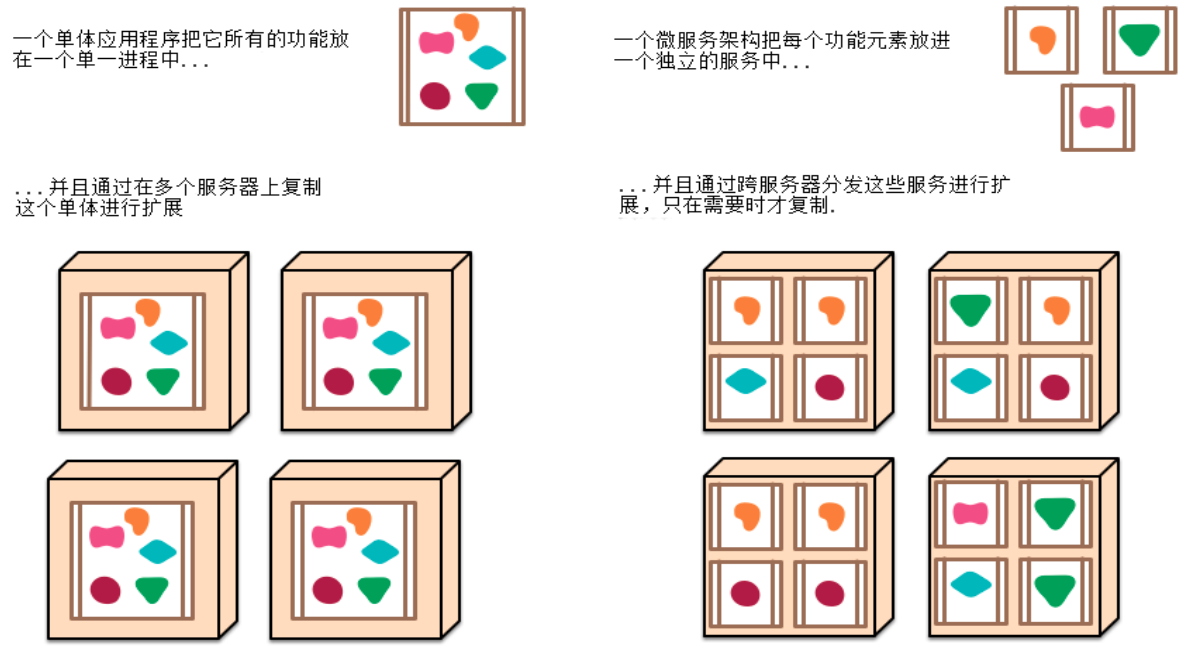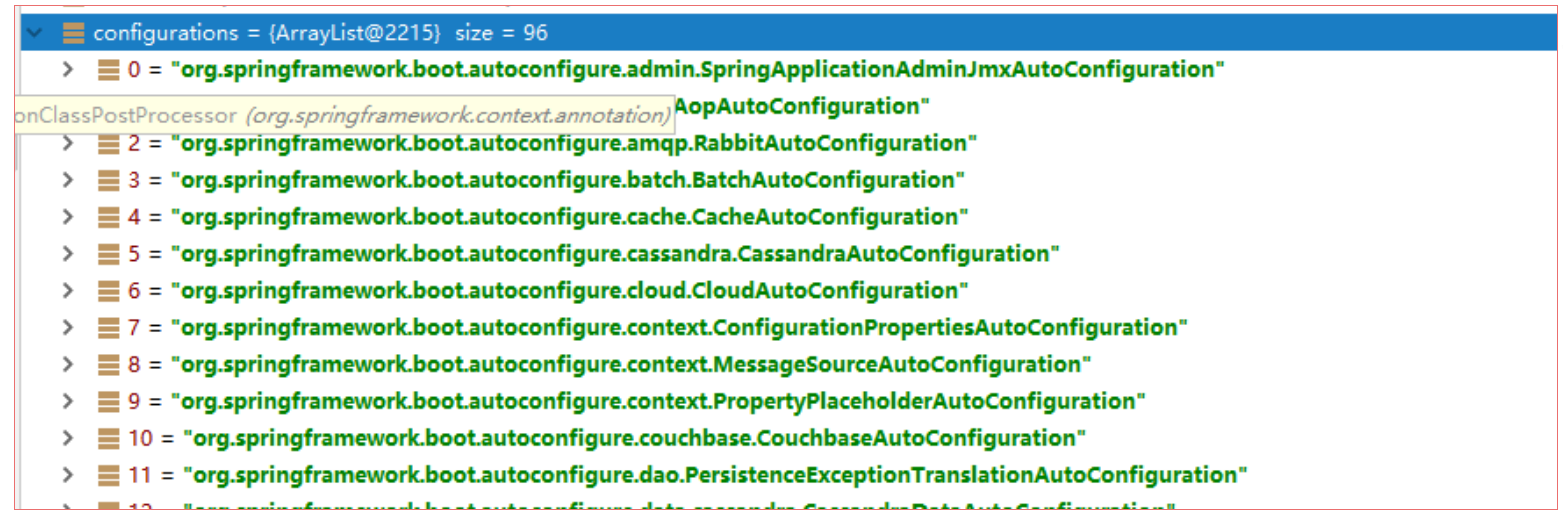SpringBoot学习记录(一)
一.SpringBoot入门
1.SpringBoot简介
简化Spring应用开发的一个框架;整个Spring技术栈的一个大整合;J2EE开发的一站式解决方案;
SpringBoot的优点:
(1) 快速创建独立运行的Spring项目以及主流框架集成
(2) 使用嵌入式的Servlet容器,应用无需打成war包
(3) starters自动依赖与版本控制
(4) 大量的自动配置,简化开发,也可修改默认值
(5) 无需配置xml,无代码生成,开箱即用
(6) 准生成环境的运行时应用监控
(7) 与云计算的天然集成
缺点:SpringBoot入门容易,精通难;如果不对spring框架的原理了解,那么对springboot的开发原理也有一定的难度。
2.微服务
架构风格(服务微化)
一个应用应该是一组小型服务;可以通过HTTP的方式进行互通
每个功能元素最终都是一个可独立替换和独立升级的软件单元

3.springboot入门程序helloworld
完成功能:浏览器发送hello请求,服务器接收请求并处理,响应Hello World
具体步骤:
(1) 创建maven工程;(jar)
(2) 导入依赖spring boot相关的依赖
根据官方文档,导入依赖
<parent> <groupId>org.springframework.boot</groupId> <artifactId>spring‐boot‐starter‐parent</artifactId> <version>1.5.9.RELEASE</version> </parent> <dependencies> <dependency> <groupId>org.springframework.boot</groupId> <artifactId>spring‐boot‐starter‐web</artifactId> </dependency> </dependencies>
(3) 编写主程序,启动springboot应用
/** * @SpringBootApplication 来标注一个主程序,说明这是一个Spring boot应用 */ @SpringBootApplication public class SpringBoot01Application { public static void main(String[] args) { //Spring应用启动起来 SpringApplication.run(SpringBoot01Application.class, args); } }
(4) 编写相关的Controller,Service
/** * @program: spring-boot-01 * @description: Spring boot HelloWorld * @author: Yukai Fan * @create: 2018-10-16 20:22 **/ @Controller public class HelloController { @RequestMapping("/hello") @ResponseBody public String hello() { return "hello world!"; } }
第二种方式:
//这个注解就是@controller与@ResponseBody的合体 @RestController public class HelloController { @RequestMapping("/hello") public String hello() { return "hello world!"; } }
(5) 运行主程序测试

(6) 简化部署
在pom文件中导入依赖
<!-- 这个插件,可以将应用打包成一个可执行的jar包 --> <build> <plugins> <plugin> <groupId>org.springframework.boot</groupId> <artifactId>spring-boot-maven-plugin</artifactId> </plugin> </plugins> </build>
只需要将这个应用打成jar包,直接使用java -jar的命令进行执行即可,不需要tomcat。因为springboot的jar包已经依赖了tomcat所需要的jar包。
4.探究Hello World程序
(1)
<parent> <groupId>org.springframework.boot</groupId> <artifactId>spring‐boot‐starter‐parent</artifactId> <version>1.5.9.RELEASE</version> </parent> 他的父项目是 <parent> <groupId>org.springframework.boot</groupId> <artifactId>spring‐boot‐dependencies</artifactId> <version>1.5.9.RELEASE</version> <relativePath>../../spring‐boot‐dependencies</relativePath> </parent> 这个是真正管理Spring boot应用里面的所有依赖的版本
Spring Boot的dependencies是版本仲裁中心;
以后我们导入依赖默认是不需要写版本;(没有在dependencies里面管理的依赖需要声明版本号)
(2) 还有一个spring-boot-starter-web;启动器依赖:
<dependency> <groupId>org.springframework.boot</groupId> <artifactId>spring-boot-starter-web</artifactId> </dependency>
spring-boot-starter:spring-boot场景启动器;帮我导入了web磨矿正常运行所依赖 的组件;
Spring Boot将所有的功能场景都抽取出来,做成一个个starters(启动器),只需要在项目里面引入相关场景的所有依赖都会导入进来。要用什么功能酒倒入什么场景的启动器。
(3) 主程序类,主入口类
/**
* @SpringBootApplication 来标注一个主程序,说明这是一个Spring boot应用
*/
@SpringBootApplication
public class SpringBoot01Application {
public static void main(String[] args) {
//Spring应用启动起来
SpringApplication.run(SpringBoot01Application.class, args);
}
}
@SpringBootApplication:Spring Boot应用标注在某个类上说明这个类是SpringBoot的主配置类,SpringBoot就应该运行这个类的main方法来启东SpringBoot应用;
@Target({ElementType.TYPE}) @Retention(RetentionPolicy.RUNTIME) @Documented @Inherited @SpringBootConfiguration @EnableAutoConfiguration @ComponentScan( excludeFilters = {@Filter( type = FilterType.CUSTOM, classes = {TypeExcludeFilter.class} ), @Filter( type = FilterType.CUSTOM, classes = {AutoConfigurationExcludeFilter.class} )} ) public @interface SpringBootApplication {
@SpringBootConfiguration:SpringBoot的主配置类;标注在某个类上,表示这是一个SpringBoot的配置类
@Configuration:配置类上来标注这个注解;
配置类-------配置文件;配置类也是容器中的一个组件;@Componment
@EnableAutoConfiguration:开启自动配置功能;以前我们需要配置的东西,SpringBoot帮我们自动配置
@Target({ElementType.TYPE})
@Retention(RetentionPolicy.RUNTIME)
@Documented
@Inherited
@AutoConfigurationPackage
@Import({AutoConfigurationImportSelector.class})
public @interface EnableAutoConfiguration {
@AutoConfigurationPackage:自动配置包,主要的作用是讲主配置类(@SpringBootConfiguration标注的类)的所在包以及下面所有子包里面的所有组件扫描到Spring容器;
(所以如果将controller类写在主配置类包的外面,那么就无法访问controller请求)
@Import(AutoConfigurationPackages.Registrar.class);
Spring的底层注解@Import,给容器中导入一个组件;导入的组件有AutoConfigurationPackages.Registrar.class;
@Import(AutoConfigurationImportSelector.class):给容器导入组件
AutoConfigurationImportSelector:导入哪些组件的选择器,将所有需要导入的组件以全类名 的方式返回;这些组件就会被添加到容器中,会给容器中导入非常多的自动配置类(xxxAutoConfiguration);就是给容器中导入这个场景所需要的所有组件,并配置好这些组件;有了自动配置类,免去了我们手动编写配置注入功能组件等工作。

SpringFactoriesLoader.loadFactoryNames(EnableAutoConfiguration.class, classLoader)
SpringBoot在启动的时候从类路径下的META-INF/spring.factories中获取EnableAutoConfiguration指定的值,将这些值作为自动配置类导入到容器中,自动配置类就生效,帮我进行自动配置工作。



根据上面的讲解可知,为什么SpringBoot简单,不需要繁琐的配置,完全由SpringBoot自动配置和解决方案?
全都在这个jar包中spring-boot-autoconfigure-1.5.9.RELEASE.jar;
二.使用Spring Initializer快速创建SpringBoot项目
IDE都支持Spring得项目创建向导快速创建一个SpringBoot项目;选择我们需要的模块,向导会联网创建SpringBoot项目;
默认生成的SpringBoot项目;
(1) 主程序已经生成好,我们只需要编写业务逻辑
(2) resources文件夹中目录结构

static:保存所有的静态资源;js css images
templates:保存所有的模板页面;(Spring Boot默认jar包使用嵌入式的tomcat,默认不使用jsp,可以使用模板引擎freeworker,thymeleaf)
application.properties:SpringBoot应用的配置文件,可以修改一些默认配置;
三.配置文件
SpringBoot 使用一个全局配置文件,配置文件吗是固定的的;
application.properties
application.yml
配置文件的作用:修改SpringBoot自动配置的默认值;SpringBoot在底层都自动配置好
YAML(YAML Ain't Markup Language)
YAML Ain't Markup Language:YAML不是一个标记语言
YAML:以数据为中心,比json,xml等更合适做配置文件;
标记语言:
以前的配置文件大多使用xml文件
1.YAML语法
(1) 基本语法
k:(空格)v:表示一对键值对(空格必须有)
以空格的缩进老控制层级关系;只要左对齐的一列数据,都是同一个层级的,属性和值是大小写敏感的
server:
port:8081
path:/hello
2.值的写法
字面量:普通的值(数字,字符串,布尔)
k:v:字面直接来写;
字符串默认不用加上单引号或者双引号;
“”:双引号不会转义字符串里面的特殊字符;特殊字符串回座位本身想表示的意思
name:"zhangsan \n lisi" 输出 zhangsan 换行 lisi
‘’:单引号会转义字符,特殊字符最终只是一个普通的字符串数据
name:'zhangsan \n lisi' 输出 zhangsan \n lisi
3.对象,Map(属性和值)(键值对)
k:v:在下一行来写对象的属性和值的关系;注意缩进
对象还是k:v的形式
friends:
lastname: zhangsan
age: 20
4.数组(List,Set)
用 - 值表示数组中的一个元素
pets:
- cat
- dog
- pig
行类写法
pets: [cat,dog,pig]
4.配置文件值注入
Yaml配置文件:
person:
lastName: zhangsan
age: 18
boss: false
birth: 2018/10/17
maps: {k1: v1,k2: 12}
lists:
- lisi
- wangwu
dog:
name: xiaogou
age: 2
JavaBean实例:
/** * @program: spring-boot-01 * @description: * 将yaml配置文件中的每一个属性值,映射到这个组件中 * @ConfigurationProperties:告诉SpringBoot将本类的所有属性和配置文件中相关的配置进行绑定;默认从全局配置文件中获取值 * prefix = "person":配置文件中哪个下面的所有属性进行一一映射 * 只有这个组件是容器中的组件,容器才能提供@ConfigurationProperties功能,所以需要加上@Compoent注解 * @author: Yukai Fan * @create: 2018-10-17 20:23 **/ @Component @ConfigurationProperties(prefix = "person") public class Person { private String lastName; private Integer age; private Boolean boss; private Date birth; private Map<String, Object> maps; private List<Object> lists; private Dog dog; @Override public String toString() { return "Person{" + "lastName='" + lastName + '\'' + ", age=" + age + ", boss=" + boss + ", birth=" + birth + ", maps=" + maps + ", lists=" + lists + ", dog=" + dog + '}'; } public String getLastName() { return lastName; } public void setLastName(String lastName) { this.lastName = lastName; } public Integer getAge() { return age; } public void setAge(Integer age) { this.age = age; } public Boolean getBoss() { return boss; } public void setBoss(Boolean boss) { this.boss = boss; } public Date getBirth() { return birth; } public void setBirth(Date birth) { this.birth = birth; } public Map<String, Object> getMaps() { return maps; } public void setMaps(Map<String, Object> maps) { this.maps = maps; } public List<Object> getLists() { return lists; } public void setLists(List<Object> lists) { this.lists = lists; } public Dog getDog() { return dog; } public void setDog(Dog dog) { this.dog = dog; } }
/** * @program: spring-boot-01 * @description: dog * @author: Yukai Fan * @create: 2018-10-17 20:26 **/ public class Dog { private String name; private Integer age; @Override public String toString() { return "Dog{" + "name='" + name + '\'' + ", age=" + age + '}'; } public String getName() { return name; } public void setName(String name) { this.name = name; } public Integer getAge() { return age; } public void setAge(Integer age) { this.age = age; } }
导入的依赖:
<!-- 导入配置处理器,配置文件进行绑定就会有提示 --> <dependency> <groupId>org.springframework.boot</groupId> <artifactId>spring‐boot‐configuration‐processor</artifactId> <optional>true</optional> </dependency>
| @ConfigurationProperties | @Value | |
|---|---|---|
| 功能 | 批量注入配置文件中的属性 | 一个一个指定 |
| 松散绑定 | 支持(即可以用last-name代替lastName) | 不支持(不能用last-name) |
| SpEL | 不支持(不能写表达式#{11*2}) | 支持(可以使用表达式计算#{11*2}) |
| JSR303数据校验 | 支持 | 不支持 |
| 复杂类型封装 | 支持 | 不支持(Map,List,Set) |
如果我们只是在某个业务逻辑中需要获取一下配置文件中的某项值,就是用@Value
如果我们专门编写一个javabean来和配置文件进行映射,我们就直接使用@ConfigurationProperties
5.
@Component @ConfigurationProperties(prefix = "person") public class Person { /** * <bean class="Person"> * <property name="lastName" value="字面值/${key}从环境变量,配置文件中获取值/#{SpEl}"></property> * </bean> */ //@Value("${person.last-name}") //lastName必须是邮箱格式 @Email @Value("${person.last-name}")
@PropertySource(value = {"classpath: 配置文件名"})
@PropertySource(value = {"classpath:person.properties"})
@Component
@ConfigurationProperties(prefix = "person")
person.properties:
person.last-name=张三 person.birth=2018/10/17 person.boos=false person.maps.k1=v1 person.maps.k2=v2 person.lists=a,b,c person.dog.name=dog person.dog.age=2
Spring Boot里面没有Spring的配置文件,我们自己编写的配置文件,也不能识别;
想让Spring配置文件加载进来,就需要@ImportResource标志在主配置类上
SpringBoot推荐给容器中添加组件的方式:
推荐使用全注解的方式
1.配置类@Configuration----->Spring配置文件
2.使用@Bean给容器添加组件
//将方法的返回值添加到容器中,容器中这个组件默认的id就是方法名 @Bean public HelloService helloService() { System.out.println("配置类@Bean给容器中添加组件了。。。"); return new HelloService(); }
(1) 随机数
${random.value}、${random.int}、${random.long}
${random.int(10)}、${random.int[1024,65536]}
(2)占位符获取之前配置的值,如果没有可以使用:指定默认值
person.last-name=张三${random.uuid} person.age=${random.int} person.birth=2018/10/17 person.boos=false person.maps.k1=v1 person.maps.k2=v2 person.lists=a,b,c person.dog.name=${person.hello:hello}_dog person.dog.age=2
(1) 多Profile文件
我们在主配置文件编写的时候,文件名可以是 application-{profile}.properties/yml
默认使用application.properties的配置;
(2) yml支持多文档块方式
server:
port: 8081
spring:
profiles:
active: prod #profiles.active:激活指定配置
---
server:
port: 8083
spring:
profiles: dev
--- #三个短横线分割多个profile区(文档快)
server:
port: 8084
spring:
profiles: prod #指定属于哪个环境
(3) 激活指定profile
-
-
命令行 --spring.profiles.active=dev
java -jar spring-boot-01-0.0.1-SNAPSHOT.jar --spring.profiles.active
可以直接在测试时,配置传入命令行参数
-
jvm参数 -Dspring.profiles.active=dev
1 2 3 4 5 6 7 8 9 10 11 12 13 14 15 16 17 18 19 20 21 22 23 24 25 26 27 28 29 30 | @Configuration //表示这是一个配置类,以前编写的配置文件一样,也可以给融日中添加组件@EnableConfigurationProperties({HttpEncodingProperties.class}) //启动指定类的ConfigurationProperties功能@ConditionalOnWebApplication( type = Type.SERVLET) //Spring底层@Conditional注解,根据不同的条件,如果满足指定的条件,整个配置类里面的配置就会生效;判断当前应用是否是web应用,如果是,当前配置类生效@ConditionalOnClass({CharacterEncodingFilter.class}) // 判断当前项目有没有这个类 CharacterEncodingFilter:SpringMVC中进行乱码解决的过滤器;@ConditionalOnProperty( prefix = "spring.http.encoding", value = {"enabled"}, matchIfMissing = true) // 判断配置文件中是否存在某个配置 spring.http.encoding.enabled;如果不存在,判断也是成立的 ,即使我们配置文件中不配置spring.http.encoding.enabled=true,默认也是生效的public class HttpEncodingAutoConfiguration { //已经与springBoot的配置文件映射了 private final HttpEncodingProperties properties; //有参构造器,参数的值就会从容器中拿 public HttpEncodingAutoConfiguration(HttpEncodingProperties properties) { this.properties = properties; }<br> @Bean //给容器添加一个组件,这个组件的某些值需要从properties中获取 @ConditionalOnMissingBean public CharacterEncodingFilter characterEncodingFilter() { CharacterEncodingFilter filter = new OrderedCharacterEncodingFilter(); filter.setEncoding(this.properties.getCharset().name()); filter.setForceRequestEncoding(this.properties.shouldForce( org.springframework.boot.autoconfigure.http.HttpEncodingProperties.Type.REQUEST)); filter.setForceResponseEncoding(this.properties.shouldForce( org.springframework.boot.autoconfigure.http.HttpEncodingProperties.Type.RESPONSE)); return filter; } |
1 2 3 4 | @ConfigurationProperties( prefix = "spring.http.encoding") // 从配置文件中获取指定的值和bean的属性进行绑定public class HttpEncodingProperties { |
一旦这个配置类生效;这个配置类就回个容器中添加各种组件;这些组件的属性是从对应的properties类中获取;
1 2 3 4 | #我们能配置的属性都是来源于这个功能的properties类spring.http.encoding.enabled=truespring.http.encoding.charset=utf-8spring.http.encoding.force=true |
-
SpringBoot启动回家再大量的自动配置类
-
我们需要的功能有没有SpringBoot默认写好的自动配置类
-
我们再看这个自动配置类中到底配置了哪些组件(只要我们要用的组件有,就不需要再配置)
-
给容器中自动配置类添加组件的时候,会从properties类中获取某些属性。我们可以在配置文件中指定这些属性的值
xxxxAutoConfiguration自动配置类:自动给容器中添加组件
xxxxProperties:封装配置文件中相关属性
注意:自动配置类必须在一定条件下才能生效
其中Positive matches:(自动配置类启用的)
1 2 3 4 5 6 7 8 9 10 11 12 13 14 15 16 17 18 19 20 21 22 23 | ============================CONDITIONS EVALUATION REPORT============================Positive matches:(自动配置类启用的)----------------- CodecsAutoConfiguration matched: - @ConditionalOnClass found required class 'org.springframework.http.codec.CodecConfigurer'; @ConditionalOnMissingClass did not find unwanted class (OnClassCondition) CodecsAutoConfiguration.JacksonCodecConfiguration matched: - @ConditionalOnClass found required class 'com.fasterxml.jackson.databind.ObjectMapper'; @ConditionalOnMissingClass did not find unwanted class (OnClassCondition) WebSocketServletAutoConfiguration.TomcatWebSocketConfiguration#websocketContainerCustomizer matched: - @ConditionalOnMissingBean (names: websocketServletWebServerCustomizer; SearchStrategy: all) did not find any beans (OnBeanCondition)Negative matches:(没有启动,没有匹配成功的自动配置类)----------------- ActiveMQAutoConfiguration: Did not match: - @ConditionalOnClass did not find required classes 'javax.jms.ConnectionFactory', 'org.apache.activemq.ActiveMQConnectionFactory' (OnClassCondition) |





【推荐】还在用 ECharts 开发大屏?试试这款永久免费的开源 BI 工具!
【推荐】国内首个AI IDE,深度理解中文开发场景,立即下载体验Trae
【推荐】编程新体验,更懂你的AI,立即体验豆包MarsCode编程助手
【推荐】轻量又高性能的 SSH 工具 IShell:AI 加持,快人一步